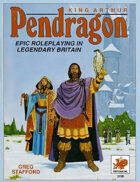
Attacking a foot soldier from horseback.Examples of circumstances that grant advantage include:

When that happens, you roll a second d20 when you make the roll and use the more advantageous die roll. Sometimes circumstances dictate that you are at an advantage when making a d20 check. Rather than applying such modifiers (which stack things heavily in favor of one combatant) I’d like to use a modified form of 5th Edition D&D’s advantage rules: If a mounted lance-wielder attacked a dagger-armed man on foot, the mounted man would receive a +5 modifier to his Lance skill for being mounted, while the man on foot would suffer a –5 modifier to his Dagger skill for the disadvantage of such a tiny weapon against a lance in this situation.

One of my pet peeves with Pendragon is its use of reflexive modifiers on opposed checks.

KING ARTHUR PENDRAGON RPG DEX ROLLS PENALTY SERIES
Through a series of linguistic changes, the Votadini became known as the Gododdin, and maintained a kingdom until their defeat by the Angles c.600 AD. They maintained client status until the Romans pulled out of Britain in 410 AD. When the Romans withdrew behind Hadrian’s Wall in 164 AD, they left the Votadini as a client kingdom, a buffer zone against the Picts in the north. The Votadini tribe, for example, lived under the direct rule of Rome between Hadrian’s Wall and the Antonine Wall from 138-162 AD. During that time, their roads, settlements, fortifications, trade arrangements, and tribal relations surely made a huge impact upon the people and landscape of Britain. In fact, a recent study shows that Britons still live roughly in the same areas they did in the 6th century! At the same time, the Romans occupied Britain to some extent from 43 AD until 410 AD. The reason I focus on the Roman and tribal elements is that the native Britons would have strong ties to their tribes, and would primarily identify as members of those tribal groups. In doing so I like to use older maps of Britain, particularly those that show the Roman settlements and roads, along with the tribal divisions of the island. Neutral: Trait modifiers for these traits total -17 through +17.Įvil: Traits modifiers total -18 or less.Īs I noted previously, I prefer to start Pendragon games in the late 5th century… either during Aurelius Ambrosius’s campaign to unseat Vortigern or during the reign of Uther. Good: Trait modifiers for these traits total +18 or more. Neutral: Trait modifiers for these traits total -7 through +7.Ĭhaotic: Traits modifiers total -8 or less. Lawful: Trait modifiers for these traits total +8 or more. When making a trait test (which will be explained in an upcoming post) to resist giving into a particular trait’s, the trait score assigns a modifier which works just like ability score modifiers. Humans: While cultural modifiers could be used, I’d simply allow humans to add 2 to up to three traits and subtract 3 from an equal number of traits. Half-Orc: +2 to Diligence and Valor/-2 to Forgiveness, Mercy, and Trust Halflings, All: +2 to Generosity, Forgiveness, and Mercy/-2 to Diligence, Temperance, and Valor Gnomes, Surface: +2 to Diligence and Prudence/-2 to Forgiveness and Temperance Gnomes, Deep: +2 to Equity, Diligence, and Prudence/-2 to Generosity, Forgiveness, and Trust * Wild elves suffer a -4 penalty to Trust I’ve provided some quick examples that I’d use in my classic Greyhawk campaign.ĭwarf, Mountain or Hill: +2 to Equity, Diligence, and Valor/-2 to Generosity, Forgiveness, and TrustĮlf, High or Grey: +2 to Diligence, Mercy, and Temperance/-2 to Equity, Modesty, and TrustĮlf, Valley, Wood, or Wild: +2 to Diligence, Temperance, and Valor/-2 to Equity, Forgiveness, and Trust* These should be left to individual DMs and be heavily dependent on the campaign world and tone that they are aiming for.


 0 kommentar(er)
0 kommentar(er)
